Excerpts from Jim Conrad's
Naturalist Newsletter
from the February 28, 2010 Newsletter issued from Hacienda Chichen Resort beside Chichén Itzá Ruins, central Yucatán, MÉXICO; limestone bedrock, elevation ~39m (~128ft), ~N18.52°, ~W95.15°
YUCATAN CAESALPINIA FLOWERING
For a couple of weeks pleasing, diffuse explosions of yellowness have adorned roadside woods edges, rather like Redbud-pink soon will appear up North, as shown below:
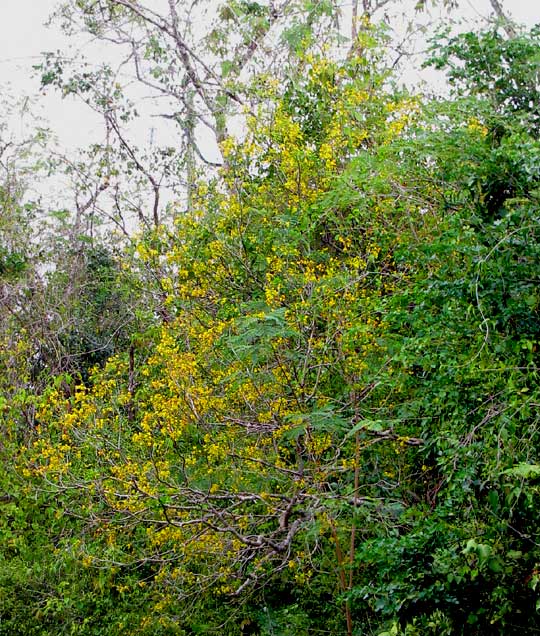
The small trees themselves are mostly leafless now, so the greenness in that picture is provided by other trees. If this yellow-flowered tree were planted alone in a park, it'd draw an audience, but here it's just a weed tree struggling for space. Once its flowers are dropped, it'll become just another nondescript tree. Up close, the blossoms, about the size of a US 25-cent piece, reveal the family the tree belongs to, as seen below:
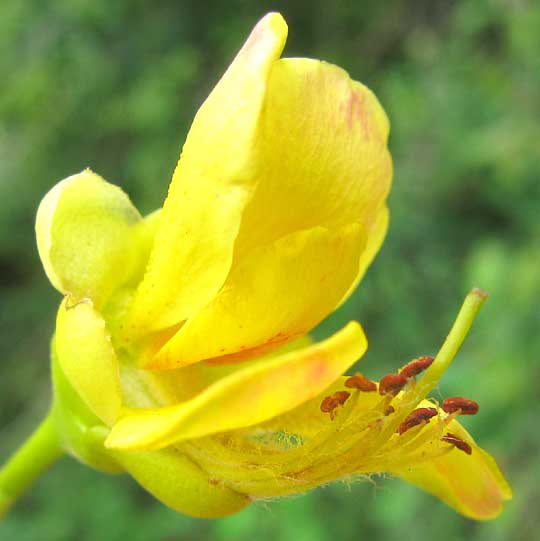
And if that doesn't ring a bell, maybe the tree's twice-compound, or "bipinnate," leaf -- a little reminiscent of a Honeylocust leaf -- will, as shown below:
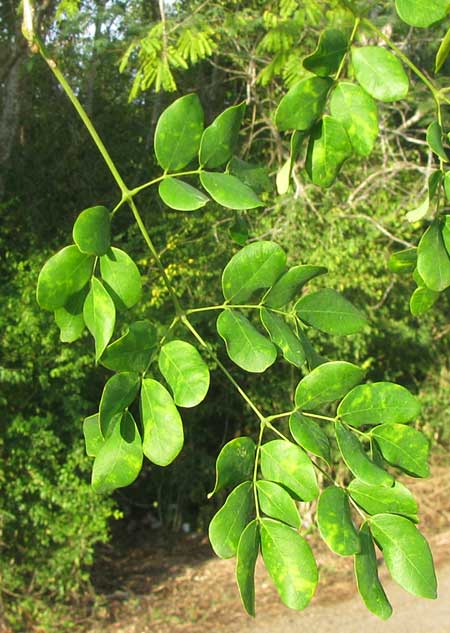
If you see a flower with five petals arranged with bilateral symmetry, with ten stamens united at their bases into a cylinder around a slender ovary and stigma-tipped style, and the plant bears compound leaves like this, you just have to think "Bean Family," and that's the case here. Honeylocust and Redbud trees also are in the Bean Family, so it all hangs together.
Our yellow-blossomed tree is Yucatan Caesalpinia, CAESALPINIA YUCATANENSIS. We've run into several trees that burst into lavish yellowness like this, but they were usually Cassias, also Bean Family members and also with five-petaled, bilaterally symmetrical flowers. However, Cassia leaves are only once compound, or pinnate, as opposed to bipinnately, compound. If you can't visualize these leaf differences you might check out our leaf page at www.backyardnature.net/lf_confg.htm.
In the diagram at that page's top, Leaf A is a classic pinnately (once-pinnate) compound leaf. Leaf G, like our Caesalpinia leaf, is bipinnate.
from the March 4, 2018 Newsletter issued from Rancho Regensis north of Valladolid, Yucatán, MÉXICO;
elevation ~40m (~130 ft), N~20.876°, W~88.170°
YUCATAN CAESALPINIA'S FLOWERS
The Yucatan Caesalpinia's yellow blossoms arrange themselves in panicle-like racemes, as shown below:
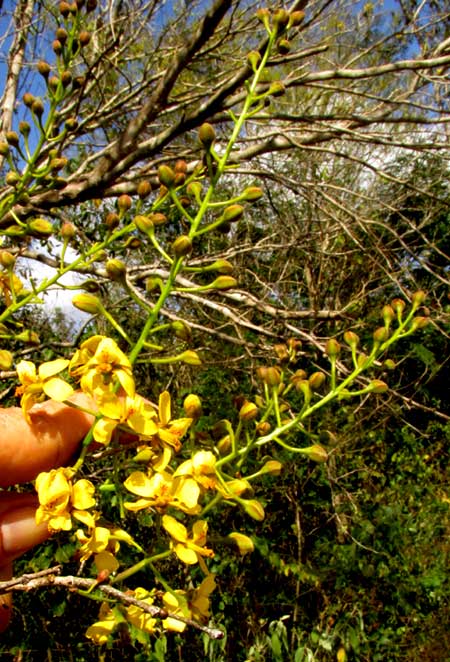
Blossoms viewed from the front show the interesting field marks seen below:
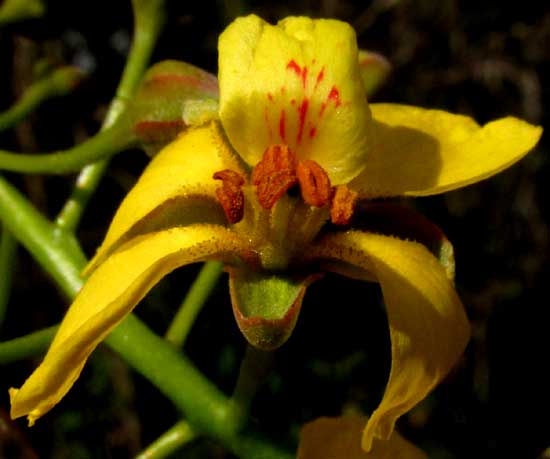
The bottom two petals are unusually narrow and held apart from another. Petal bases are covered with short, gland-tipped hairs. The calyx's lowest sepal is deeply scoop-shaped, and the sprinkling of redness on the top petal occurs on nearly every flower. From the side, the blossom's stamens are shown to be of different lengths, with anthers of different sizes, shown below:
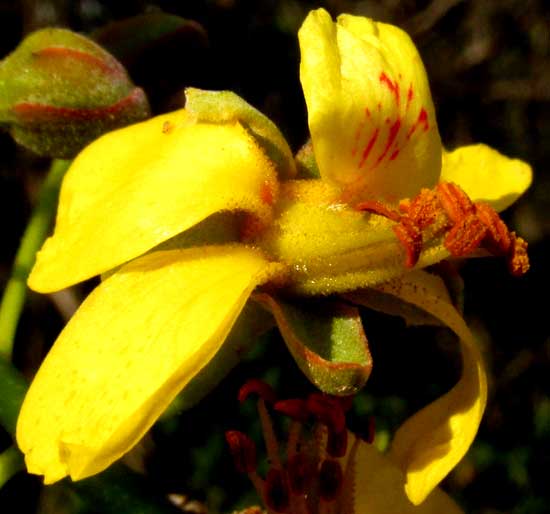
from the April 30, 2017 Newsletter issued from Rancho Regensis north of Valladolid, Yucatán, MÉXICO;
elevation ~40m (~130 ft), N~20.876°, W~88.170°
CAESALPINIA'S EXPLODING LEGUMES
Several Yucatan Caesalpinias grow around the hut and nowadays they're attracting attention in an unexpected way. Below, you can see part of a tree in the current condition, its branches leafless for the dry season but bearing large numbers of short legumes:
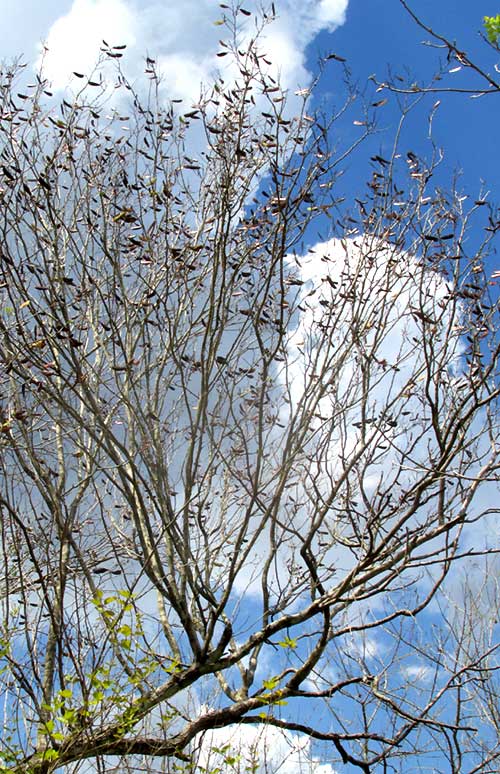
The legumes are explosive. Here at the end of the dry season they are crispy dry and, especially in mid afternoon when the sun beats down the hardest, they are designed so that their two sides pull against one another until finally something snaps, the sides fly apart, and beans are thrown everywhere -- seed dispersal through legume detonation. A couple of unexploded legumes are shown below:
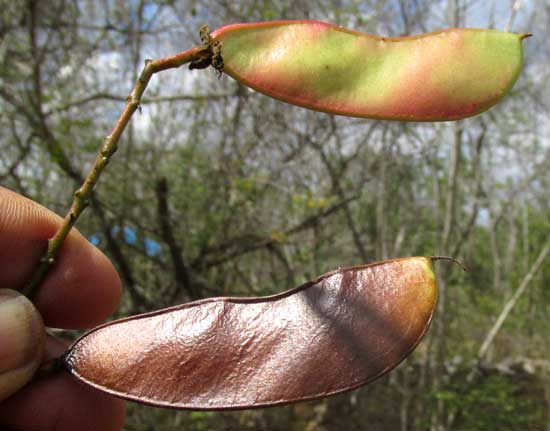
An open legume displaying its beans is shown below:
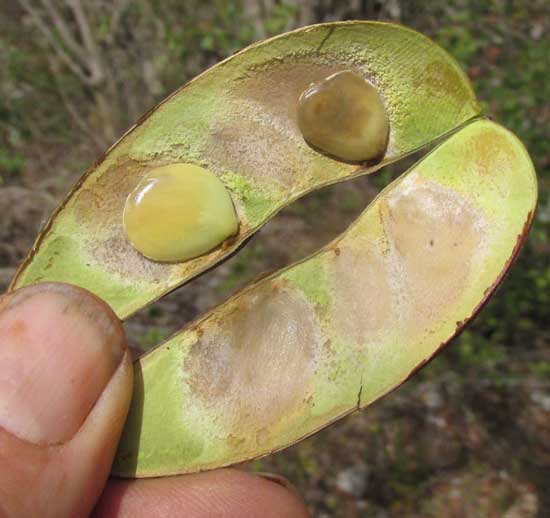
The snapping legumes can be heard from 20 feet and more away. Most of the day there are no snaps, but in mid afternoon when the sun shines brightest you might hear them every ten or fifteen seconds, so it's quite a performance. Our afternoons are partly cloudy, so part of the show is that the very moment a cloud covers the sun the snapping ceases instantly,but when the sun returns, so does the snapping.
Interestingly, a second tree at the ranch also produces snapping legumes, and it's also a member of the genus Caesalpinia, though it's not native to this area. That's the Dwarf Poinciana, Caesalpinia pulcherrima, much planted in the tropics worldwide because of its beautiful flowers. You might be interested in comparing the two species' blossoms -- in seeing two variations on the Caesalpinia theme. The Yucatan Caesalpinia's flowers appear at www.backyardnature.net/yucatan/caesgaum.htm
The Dwarf Poinciana's flowers are shown at www.backyardnature.net/yucatan/d-poinci.htm
from the May 10, 2018 Newsletter issued from Rancho Regensis north of Valladolid, Yucatán, MÉXICO;
elevation ~40m (~130 ft), N~20.876°, W~88.170°
GLANDS ON EMERGING LEAVES
In our above flower pictures you can see tiny, stalked glands at the base of the flowers' petals and on their stamens' filaments. Now I've noticed another kind of gland. My attention was drawn to them when, because of recent rains, most Yucatan Caesapinia trees in our area began breaking their dry-season dormancy by opening up their buds to release new stems bearing tiny leaves. The masses of immature stems and leaves as they break from their buds look like some kind of fat, deformed, hairy, yellow-green insect stuck in the axils of last season's leaves, as shown below:
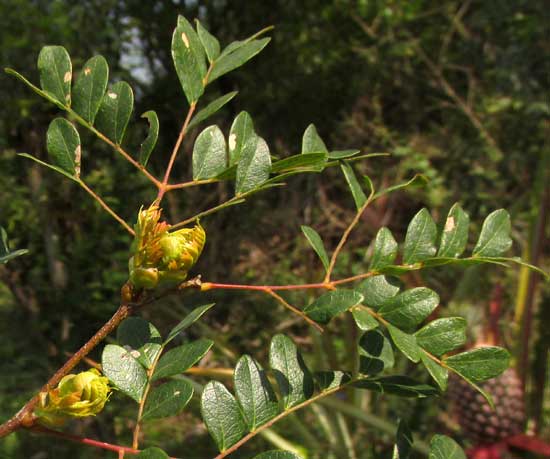
A close-up of the blob focusing on a doubly-compound, or "bipinnate," leaf arising from expanded bud scales is shown below:
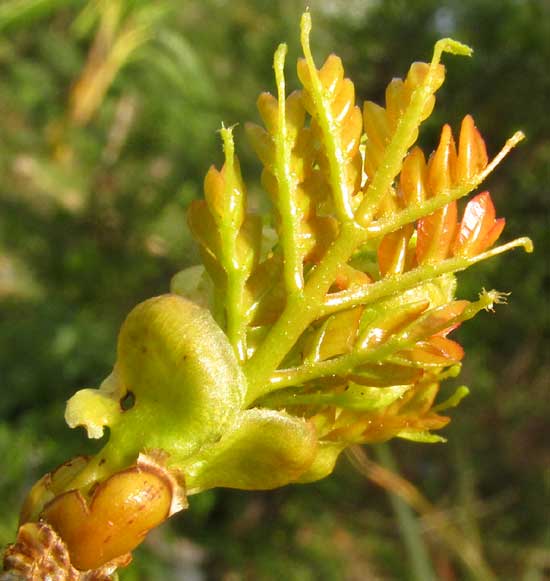
The glands arise at the tips of the midribs, or rachillas, of the seven main leaf divisions, or pinnae, looking like greenish golf clubs. Notice that the hooked tips of some glands bear tiny hairlike appendages, effectively increasing each gland's exposed surface area. An even closer look, better showing the glands' attachment to the rachilla tips, is shown below:
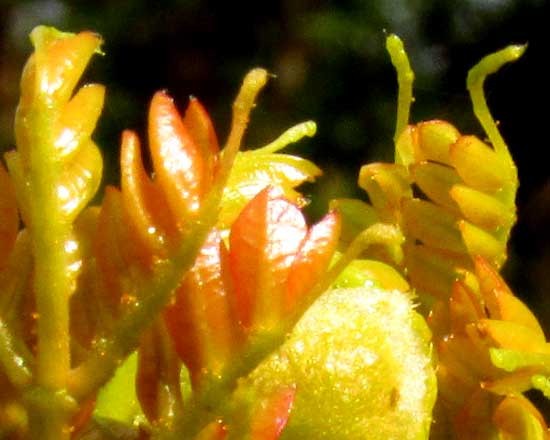
Often we've seen glands that apparently were providing something desirable such as nectar to ants and other invertebrates, but my impression is that these glands are to ward off visitors who might nibble on the leaves' soft tissue.
While watching a tree with numerous expanding buds, several times I saw ants climbing the stems and exploring among the older leaves as well as these emerging ones, apparently looking for prey. Several times ants embarked into the enlarging mass of stems and leaves, started to climb one of the gland-bearing pinnae, but each time turned around before reaching the tip. My impression was that they left the area faster than they'd come. One ant climbing a pinna simply fell off onto the ground. Was he clumsy, or did he encounter some kind of chemical in the air surrounding the pinna-tip gland that shocked him so violently he simply wanted to escape from the area as quickly as possible?
A few days after the above photos were taken, and the new leaves were nearly as large as last year's, at the tips of most pinnae the stalked glands were missing, but on some, brown, shriveled, dried-up stalks still could be seen. However, now most new leaves and stems on most trees were heavily infested with an especially tiny aphid, so the glands didn't prevent that.
from the February 18, 2018 Newsletter issued from Rancho Regensis north of Valladolid, Yucatán, MÉXICO;
elevation ~40m (~130 ft), N~20.876°, W~88.170°
YUCATAN CAESALPINIA LEAVES YELLOWING
Nowadays this tree is doing something else worth paying attention to, shown below:
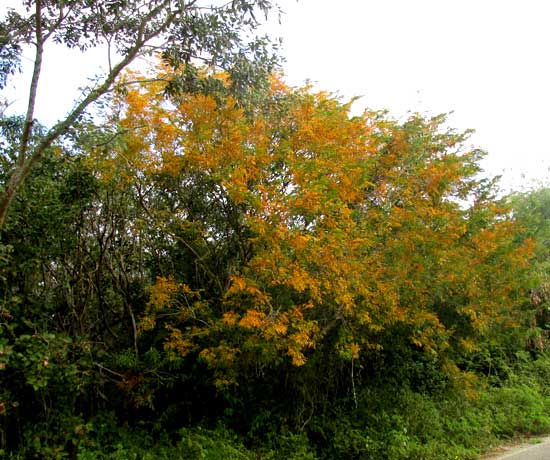
To anyone with memories of autumn in the Temperate Zone, this looks like a tree getting ready to lose its leaves for winter. But here we have no winter, so it's really getting ready for the worst part of the dry season, which is starting now. This tree's leaves are the most brightly colored of any woody plant I can think of down here, and it feels odd seeing one our hotter afternoons. Many woody species lose their leaves in advance of the dry season, but normally their green leaves simply fall off, or develop certain brown parts on them, or become a pale, slightly yellowish-green hue before dropping, but nothing like this.
Not all Yucatan Caesalpinias here are yellow now. The one in the picture is especially colorful. Some trees of the species are still dark green and some have lost every leaf on them. Others are mostly leafless, with a few yellow leaves still hanging on. Some of the leafless trees bear slender arrangements of immature flower buds, promising to produce spectacularly yellow-flowered trees such as those shown on our page.